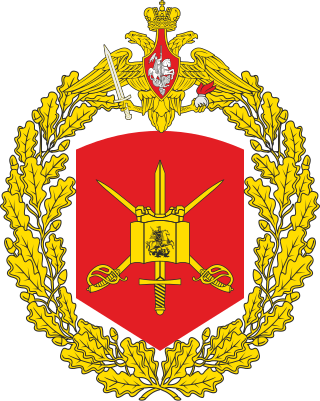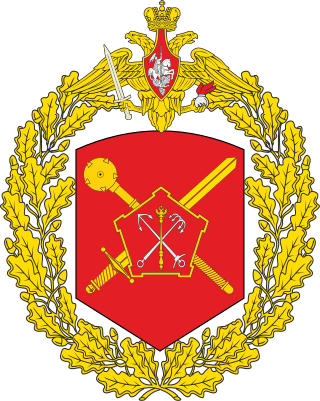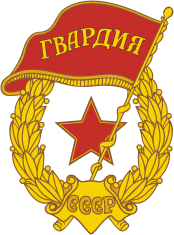
The 1st Guards Tank Army is a tank army of the Russian Ground Forces. в/ч 73621.
A tank corps was a type of Soviet armoured formation used during World War II.
A mechanised corps was a Soviet armoured formation used prior to the beginning of World War II and reintroduced during the war, in 1942.

The Order of Lenin Moscow Military District is a military district of the Armed Forces of the Russian Federation. Originally it was a district of the Imperial Russian Army until the Russian Empire's collapse in 1917. It was then part of the Soviet Armed Forces. The district was awarded the Order of Lenin in 1968. In 2010 it was merged with the Leningrad Military District to form the new Western Military District.

The 6th Combined Arms Army is a field army of the Red Army and the Soviet Army that was active with the Russian Ground Forces until 1998 and has been active since 2010 as the 6th Combined Arms Army. Military Unit number в/ч 31807.

The 90th Guards Tank Division was a division of the Soviet Army, and then of the Russian Ground Forces.

The 51st Guards Mechanized Brigade was a formation of the Ukrainian Ground Forces, stationed at Volodymyr in Volyn Oblast, on the border with Poland. The Brigade drew its history from the 15th Guards Rifle Division of World War II, which was converted into the 15th Guards Motor Rifle Division in 1957. The division was renumbered as the 51st Guards Motor Rifle Division in 1965 and awarded the honorific Perekop in honor of the 51st Rifle Division of the Russian Civil War.

The 38th Separate Guards Vitebskaya order of Lenin Red Banner order of Suvorov Motor Rifle Brigade is a mechanized infantry brigade of the Russian Ground Forces, part of the Eastern Military District. Military Unit в/ч 21720.

The 20th Guards Carpathian-Berlin Motor Rifle Division is a formation of the Russian Ground Forces, originally formed within the Soviet Red Army as the 3rd Mechanised Corps. The division was reformed in 2021 from the former 20th Guards Motor Rifle Brigade.
The 12th Guards Uman Orders of Lenin Red Banner and Suvorov Tank Division was a tank division of the Soviet Ground Forces. It drew its history from the World War II 16th Tank Corps. It was redesignated successively as 12th Guards Tank Corps (1943) and 12th Guards Tank Division (1946).

The 28th Army was a field army of the Red Army and the Soviet Ground Forces, formed three times in 1941–42 and active during the postwar period for many years in the Belorussian Military District.
The 5th Guards Zimovnikovskaya order Kutuzov II degree Motor Rifle Division, named on the 60th anniversary of the USSR, was a military formation of the Soviet Ground Forces. It was formed from the 6th Mechanized Corps created in 1940 and destroyed in 1941 in the beginning of Operation Barbarossa. The corps was reformed in November 1942 under the same name, but with a different organizational structure. In January 1943, the 6th Mechanized Corps was granted "Guards" status and became the 5th Guards Mechanized Corps.

The 11th Guards Mechanized Brigade is a unit of the Armed Forces of Belarus based in Slonim. The 11th Guards Brigade traces its history back to the 1942 formation of the 6th Tank Corps of the Soviet Army during World War II.
The 3rd Guards Airborne Division was a Red Army division of World War II. In December 1945 it appears to have become 125th Guards Rifle Division, while serving with 35th Guards Rifle Corps, 27th Army, Carpathian Military District.
The 207th Rifle Division began its combat path under unusual circumstances. It was partly formed for the first time as a standard Red Army rifle division in the spring of 1941, before the German invasion, but was never completed. A second formation began in April 1942 and was completed on June 1, after which it was sent to the Stalingrad Front. Heavily depleted in counterattacks against the north flank of German Sixth Army, by November the survivors were reassigned and the division disbanded. The 207th was formed for a third time in June 1943, and fought its way through the central part of the Soviet-German front, ending the war in the heart of Berlin in the battle for the Reichstag. The division saw postwar service in the Group of Soviet Forces in Germany.
The 22nd Guards Tank Division was a tank division of the Soviet Army. The division traced its lineage back to the World War II 7th Guards Airborne Division, which became the 115th Guards Rifle Division after the end of the war. In 1957, the 115th became the 22nd Guards Tank Division. The division was based in the small military town of Novoye, which was quickly renamed Cherkaske after the Cherkassy honorific title of the division. From May 1957, it was part of the 6th Guards Tank Army, relocated from the Transbaikal. The division's 223rd Tank Regiment was transferred from the 16th Tank Division of the 6th Guards Tank Army, formerly stationed in Mongolia. The division was maintained as a high strength cadre division, not ready for combat. It was disbanded in 1990 to make room for the 93rd Guards Motor Rifle Division, which had been withdrawn from Hungary.
The 4th Guards Motor Rifle Division was a motorized infantry division of the Soviet Army during the Cold War.
The 215th Rifle Division was an infantry division of the Red Army during World War II that continued to serve in the Soviet Army during the early years of the Cold War. It was the successor to a motorized division of that same number that was destroyed during the Battle of Kiev in September 1941.








